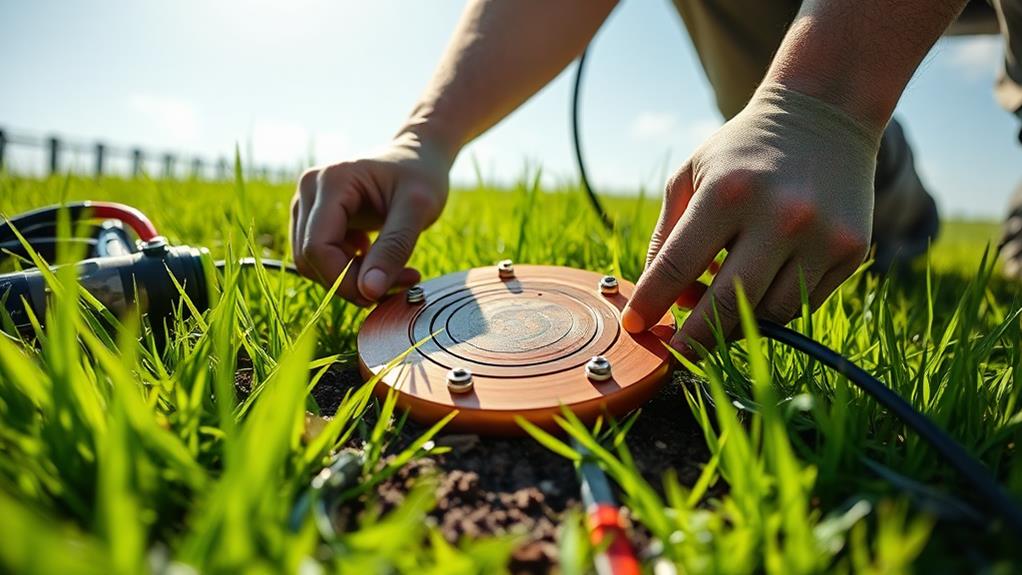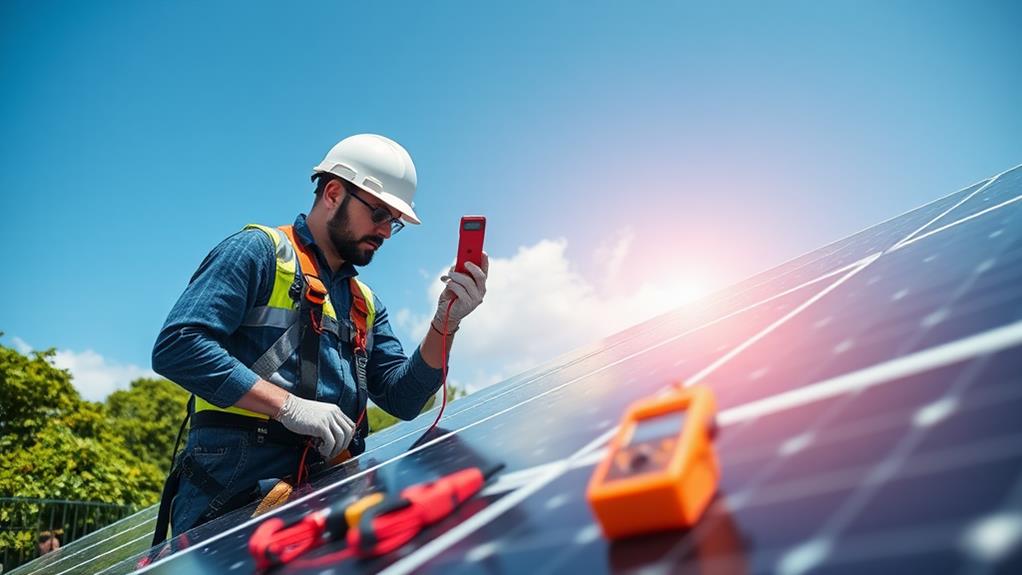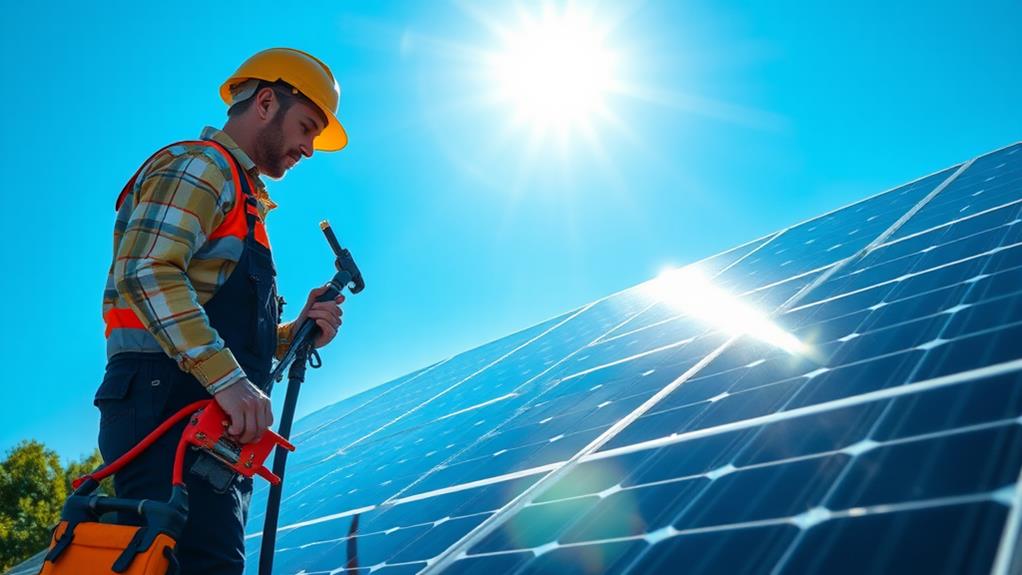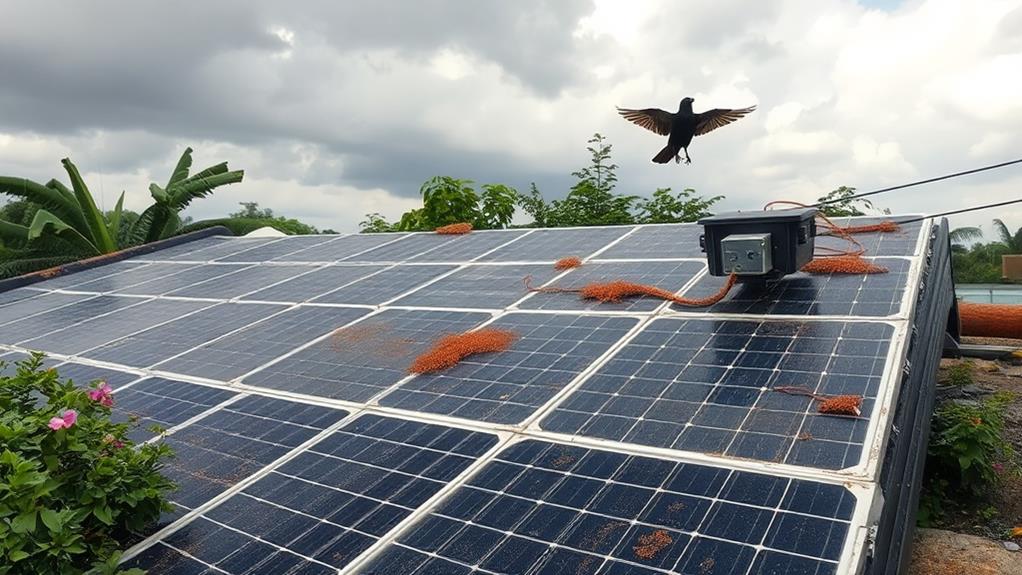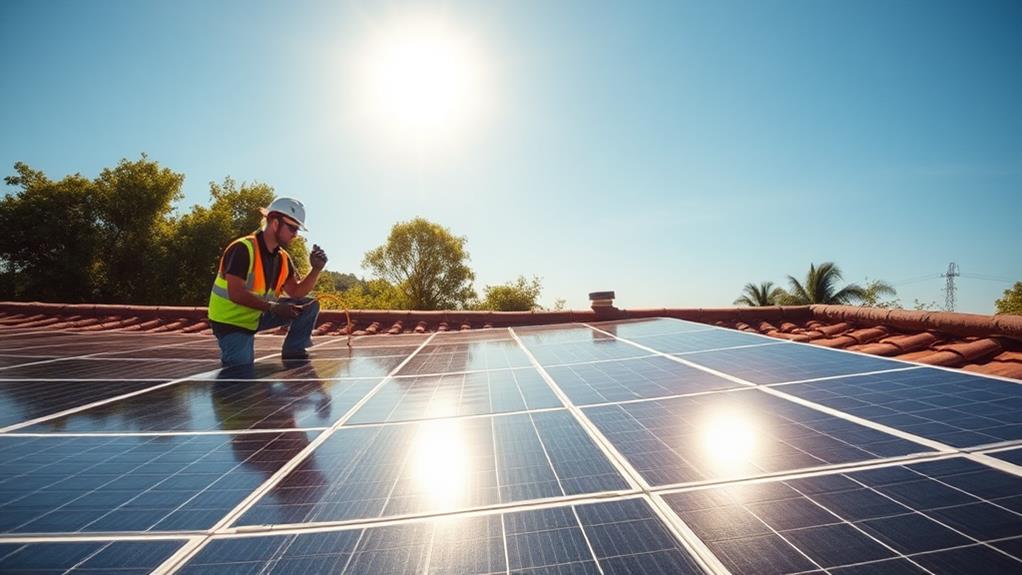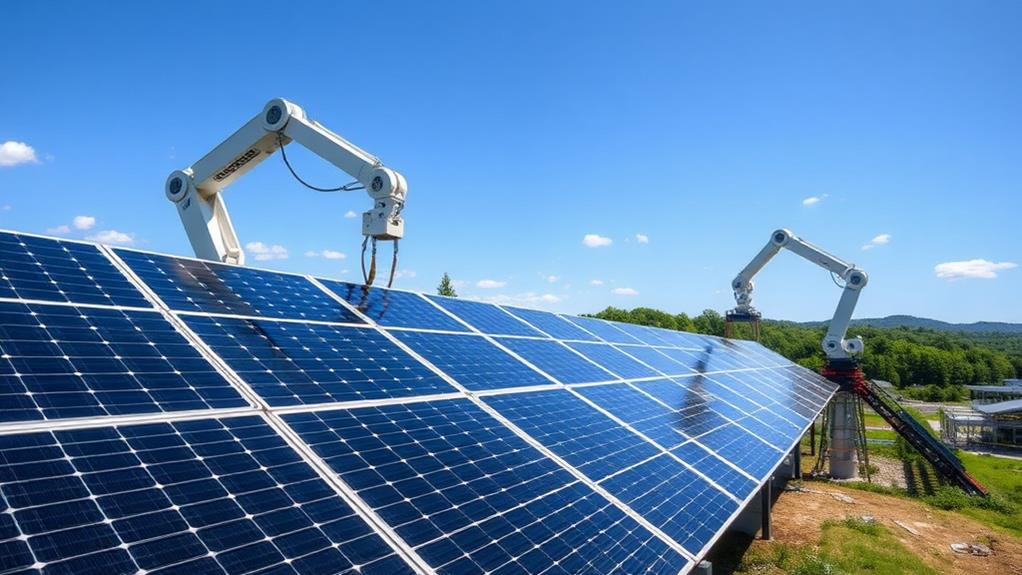To properly install solar earthing plates, we need copper or galvanized steel plates, grounding rods, and quality grounding wire. Tools like a hammer, drill, and multimeter are necessary. Safety equipment such as insulated gloves and goggles will keep us protected. We start by evaluating the site, confirming good soil conductivity, and avoiding obstacles. Install the plates at the recommended depth, securing all connections with copper clamps. Following these steps helps disperse excess electrical energy, enhancing system reliability. Regular testing with a multimeter guarantees connections remain intact. By following these guidelines, we'll achieve a safe and efficient solar installation.
Key Takeaways
- Select optimal location with good conductivity and low soil resistivity for plate installation.
- Use high-quality copper or galvanized steel plates for effective fault current dispersion.
- Ensure secure connections using grounding screws and clamps to maintain system integrity.
- Regularly test and verify earthing system with a multimeter to confirm proper grounding.
- Perform routine maintenance to prevent corrosion and ensure reliable system performance.
Understanding Solar Earthing
Understanding solar earthing is essential for anyone involved in solar installations. As a community focused on safe and efficient energy solutions, knowing the grounding system's role in maintaining electrical safety is vital.
Solar earthing plates, typically made from robust copper or galvanised steel, form the basis of this system. They provide a low-resistance path to channel fault currents securely into the ground, protecting our installations and ourselves.
Burying these plates in the ground allows them to effectively disperse excess electrical energy, ensuring that systems run smoothly and safely. Proper installation of these plates isn't just a technical necessity; it represents a commitment to the performance and safety of solar setups.
Taking these steps enhances the reliability and longevity of systems, creating a safer environment for everyone involved.
Regular testing and maintenance of solar earthing plates are imperative. This ongoing vigilance ensures that the grounding system remains effective over time.
As we work together to harness solar energy, we must remember the importance of a well-functioning earthing system in safeguarding our collective investment in sustainable power sources.
Tools and Materials Needed
Let's gather the necessary tools and materials for our solar earthing plate installation.
We'll need:
- a hammer
- drill
- grounding rod
- multimeter for testing
- copper or galvanized steel earthing plates
- grounding wire
- clamps
Ensuring we've the right safety equipment and chemical compounds for enhancing soil conductivity is vital for a successful and secure setup.
Essential Installation Tools
Installing solar earthing plates requires the right tools and materials for a safe and effective setup. The key elements secure proper grounding and effective connections for a successful installation. A hammer is vital for driving the plates securely into the ground. This step lays the foundation for the grounding system, ensuring stability and security.
Properly sized spanners or socket sets are essential for tightening bolts and connections. These tools help achieve the snug, effective connections necessary for a reliable earthing system. Loose connections could compromise safety and performance.
Grounding wire and clamps are crucial, as they connect the earthing plates to the electrical system. These components are the backbone of the setup, facilitating the flow of electrical current and ensuring everything functions as it should. Safety gear is indispensable; insulating gloves and safety goggles protect against electrical hazards during installation.
Required Earthing Materials
When setting up solar grounding plates, using the correct materials and tools is crucial for a successful installation. This ensures our solar systems remain safe and efficient. The primary material used is high-quality copper, chosen for its excellent conductivity and resistance to corrosion, which provides a reliable path for fault currents, ensuring safety and optimal performance.
Copper clamps are essential, securing the grounding wire to both the grounding plate and the grounding rod. The grounding wire plays a critical role, directing any stray electrical currents safely into the ground, protecting our solar setup from electrical faults.
A grounding rod, inserted into the soil, establishes a strong connection with the earth.
Soil moisture and correct plate placement are vital for successful installation, as these factors maintain the low-resistance path needed for effective grounding. Additionally, the size of the grounding plate may vary depending on system requirements and local regulations. Careful selection and use of these materials help develop a secure and efficient solar system.
For those looking into product recommendations, consider using the Earth Rod Clamp, a reliable choice for securing connections. The Heliax Grounding Kit is another option, known for its durability and effectiveness. These products, priced in South African Rand, offer dependable solutions for grounding needs.
Safety Equipment Essentials
When installing solar earthing plates, having the correct safety equipment is essential. Safety precautions must always be a priority. An equipped team is a safe team, and it's vital everyone feels included and protected.
Insulated gloves are a must to protect against electrical shocks. They're the primary defence when handling electrical components.
A multimeter is also essential. This device verifies proper grounding connections, ensuring the system's electrical safety.
Grounding rods are important too. They create a secure connection between the earthing plate and the ground, ensuring reliability.
Personal protective equipment is crucial. Safety goggles and sturdy footwear offer protection against unexpected hazards. Properly insulated tools, such as screwdrivers and pliers, are necessary for safely handling electrical components.
For your safety gear, consider brands like Ansell for gloves, Fluke for multimeters, and Klein Tools for insulated tools. Always choose quality to ensure maximum protection.
Site Assessment and Preparation
Conducting a thorough site assessment is a crucial step in the successful installation of solar earthing plates. Initially, focus on soil analysis. Evaluate soil composition and moisture levels to find the ideal spot for the earthing plates. Identifying areas with optimal soil resistivity is essential as it directly affects the grounding depth and efficiency of electrical dissipation. Understanding the soil's characteristics allows informed decisions to enhance the performance of the solar system.
Proceed with an obstruction survey. Survey the installation site for any potential obstructions that might impede the placement or effectiveness of the earthing plates. Consider the distance and orientation of nearby structures to ensure the system operates at its best.
For instance, avoid areas with tall buildings or large trees that may cause shading or interference.
Adequate site assessment and preparation are key to achieving goals and making a positive impact on the environment. Collaborate to create a brighter, more connected future.
Step-by-Step Installation
Let's start by selecting the optimal location for our earthing plates, focusing on areas with good conductivity and compliance with local regulations. Once we've identified the right spot, we'll install the grounding components at the correct depth, ensuring they meet industry standards for stability and reliability.
At last, we'll make secure connections between the solar panels, inverters, and earthing plates to establish a safe path for fault currents and lightning protection.
Selecting Earthing Plate Location
To select the ideal location for solar earthing plates, assess soil composition and moisture levels. A comprehensive soil analysis ensures effective earthing by identifying areas with optimal conductivity. The objective is to establish a robust, reliable system that provides safe and efficient energy use.
It's important to avoid high-traffic zones. This means steering clear of paths where vehicles or construction activities might interfere with the earthing system. Considering these factors protects the solar installation and maintains an orderly environment.
Grounding plates should be placed at a minimum depth of 2.4 metres. This guarantees proper earthing and low resistance, essential for the safety and performance of the solar system. For larger installations, implementing multiple earthing plates can significantly enhance effectiveness.
For example, the Copper Earth Plate from Earthing Solutions, available in various sizes, can be a suitable choice for installations requiring multiple earthing points.
Installing Grounding Components
Understanding the importance of grounding components is crucial for the safety of our solar systems. These components ensure that our setup operates securely and efficiently, highlighting our shared commitment to sustainable energy.
Unpacking the copper earthing plates is the first step. These plates are renowned for their excellent conductivity and durability. It's essential to follow the manufacturer's guidelines meticulously for effective grounding. Proper grounding maintains the integrity of the solar system.
The earthing plates must be secured on a solid foundation, ensuring they're stable and capable of directing excess electricity safely into the ground.
Once the plates are in place, it's important to achieve the effective dissipation of surplus electricity, safeguarding our systems from potential electrical hazards. Double-check the stability of the mounted plates to confirm that the installation is secure and reliable.
Each action in this process contributes to building a robust solar system. Our efforts in installing these grounding components play a vital role in promoting a safer, more sustainable energy future for everyone.
Ensuring Secure Connections
With our foundational components firmly in place, the focus shifts to securing reliable connections to maintain the integrity and safety of the solar system. Using copper earthing plates is recommended for their excellent conductivity and durability. These plates are essential for creating a dependable grounding system. Grounding screws should be used to fasten these connections tightly. Ensuring these connections are secure is crucial to maintaining electrical integrity, as loose connections can lead to inefficiencies or potential hazards in the solar setup.
Proper bonding of the earthing plates to the solar components is necessary for effective grounding. Industry standards and regulations should be followed to ensure every connection meets safety requirements. This adherence upholds the system's safety and strengthens the community's commitment to sustainable practices.
Regular inspections are important. Habitually checking these connections for any signs of corrosion or damage guarantees the solar system continues to perform optimally. This practice ensures the system serves both users and the shared environment reliably. Following these steps contributes to a resilient and safe solar installation, reinforcing the commitment to renewable energy.
For specific products, consider using the Schneider Electric Copper Earthing Plate, known for its durability, priced at approximately ZAR 500.
For grounding screws, the RS PRO M6 Grounding Lug ensures a secure fit, priced at about ZAR 120 for a pack of 10. Regular maintenance is crucial, ensuring the components remain in top condition.
Testing and Verification
Testing and verification of solar earthing plates are essential to ensure their effectiveness and safety. Initial resistance measurements confirm proper grounding, a key factor that assures optimal functioning of solar systems. During this process, corrosion checks are also performed to ensure connections remain intact and reliable over time. This protects community investments and maintains trust in the system.
Soil resistivity is another crucial factor affecting the efficiency of the earthing system. Precise results are achieved with specialised equipment, such as earth testers, which provide accurate measurements. This ensures installations meet necessary standards, fostering a sense of security in a well-protected environment.
Regular testing and verification promote a culture of safety and reliability. Commitment to these practices contributes to an inclusive and forward-thinking community, valuing consistency and protection for everyone involved. Let's continue to uphold these standards together.
Maintenance and Troubleshooting
Maintaining our solar earthing plates in peak condition involves regular upkeep. Focus on corrosion checks, tight connections, and spotting any damage. Preventing corrosion ensures the system's effectiveness, guaranteeing our solar installations operate safely and efficiently. Let's commit to this routine, ensuring our system remains resilient for years.
Periodic testing of our earthing system with specialised equipment helps identify potential issues before they lead to failures. High resistance readings signal potential problems; spotting these early allows for effective troubleshooting. Damaged components should be replaced promptly to restore the system to optimal function. This proactive approach secures our solar investments, ensuring they remain reliable.
Proper bonding and corrosion-free connections between earthing plates and solar components are crucial for system reliability. Adhering to industry standards and regulations for maintenance ensures both safety and performance. These guidelines serve as our roadmap, ensuring we meet expectations and belong to a community that values quality and safety.
Let's tackle maintenance and troubleshooting together, ensuring our solar systems operate efficiently. Our collective efforts secure a sustainable and effective future for our solar solutions.
Conclusion
We have explained how to install solar earthing plates to ensure your system is safe and efficient. With the right tools and a comprehensive site assessment, the installation process becomes simple. Testing and verification are essential steps to make sure everything is working correctly. Regular maintenance will help prevent issues, but if problems occur, our troubleshooting tips can guide you. Let's use solar energy safely and efficiently, knowing we have set up a reliable grounding system.
If you have any questions about our products—Rail-Less Solar Brackets, End Spacers, Structural Brackets, Ground Mounted Solar Systems, Corrugated Brackets, and Earthing Plates—or our services such as the DeoSizer Tool, Evaluation and Design, Maintenance and Support, and Solar Installations, please feel free to get in touch with Deo Solar. We are here to assist you.

